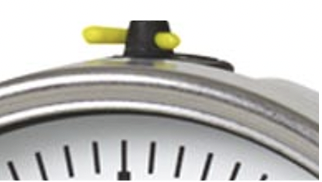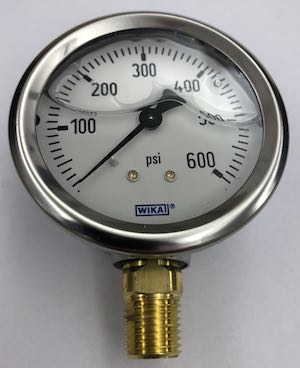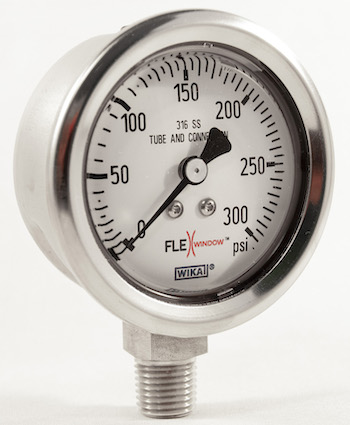
In WIKA’s new FlexWindow™ liquid-filled gauge, an optically clear liquid silicone rubber (LSR) replaces glass or polycarbonate for greater safety and durability, unimpaired reading, and no need for pressure venting.
Liquid-filled gauges are excellent solutions for applications with vibration, pulsation, shock, exposure to the elements, and other adverse conditions. Although a little more expensive than dry gauges, liquid-filled gauges more than pay for themselves over time by extending the instrument’s service life. The case filling also reduces or eliminates pointer flutter, making the dial easier to read.

WIKA‘s lever plug
Pros and Cons of a Pressure Gauge Vent Plug
For ≤300 psi pressure ranges, gauges require some type of vent valve, compensating membrane, or other mechanism for pressure compensation. Otherwise, changes in ambient temperature would distort the measured pressure. (No compensation is necessary in gauges with >300 psi pressure ranges, as the pressure built up inside the case is negligible in relation to the full scale range.) Some manufacturers vent via a push-up pin. WIKA uses a lever plug that can be easily moved to an open position to relieve pressure inside the case.
While venting is a good solution for pressure compensation, it is not always practical or possible for liquid-filled gauges.
Problems with Liquid-Filled Gauges
There are two primary issues that can arise in liquid-filled gauges:
- Air bubbles can form on gauges that are partially filled with liquid, making them difficult to read.
- Gauges that are 100% filled require venting, which can be difficult depending on the location of the gauge.
The trouble with bubbles and vents

large air bubble in a gauge
Most liquid-filled gauges are filled to only 85–95%; not filling it completely allows for additional pressure compensation while losing none of the protective benefits. However, this means air bubbles could appear on the dial face. On the one hand, a large bubble compensates for pressure buildup because air is compressible. On the other hand, the bubble can impair the reading.
In applications where a clear reading is paramount, the case should be filled to 100%. Without the compensating effects of the air bubble, venting the case becomes even more critical. However, manual venting is an issue where gauges are set into a panel, such as in fire trucks and utility vehicles, making it very difficult to access the valve to open or close it.
Whenever the vent valve is not readily accessible, the normal recommendation is to leave it in an open position. Yet this poses two problems:
- A moving vehicle could cause the case fill to spill.
- Venting is not possible when the gauge is not installed in an upright position.
Would an internal membrane or bladder work in this situation? Yes, but with caveats. In most cases, especially for back-mounted gauges, there is very little or no space to add a bladder. In addition, a rubber bladder adheres well to plastic casing, but not to a stainless steel one. Stainless steel is the preferred case material for industrial type pressure gauges.
To realize the protective benefits of case filling without the need to vent, WIKA came up with a revolutionary solution to compensate for internal pressure buildup in liquid-filled pressure gauges.
WIKA’s Innovative Solution: The FlexWindow™

WIKA’s liquid-filled gauge with FlexWindow
In pressure gauges with a FlexWindow, an optically clear disk made of liquid silicone rubber (LSR) is both the instrument’s window and the pressure compensator. In effect, it acts like a membrane, compensating for temperature-related overpressure or negative pressure by expanding or contracting.
This solution comes with many other advantages:
1. Improved gauge readings
Because LSR flexes with pressure changes, the gauge can be filled to 100%. This means no reading impairments from large bubbles or optical effects. In addition, the FlexWindow is hydrophobic (repels water), is scratch and crack resistant, and – with its slight curve – has a magnifying effect. All these factors make the dial even easier to read.
2. Long-term durability
LSR is extremely tough. It is shatterproof, virtually impervious to punctures, and mechanically stable down to −67°F (−55°C) and up to 300°F (150°C), making it autoclavable. As this material is UV stable and resistant to yellowing, bacteria, and ozone, pressure gauges with the FlexWindow are ideal for outdoor applications. What’s more, LSR is much more resistant to chemicals than polycarbonate or PMMA plastic.
3. Ease of panel mounting
With its protruding design, a vent plug makes it very difficult to panel mount traditional liquid-filled gauges. The flat-fill plug that comes with the FlexWindow eliminates that issue.
4. Greater safety
The FlexWindow has all the necessary features for it to be considered a safety window. The material is far more flexible than glass, thereby greatly reducing the chance of breakage. While flexible enough not to break, it is particularly valuable in applications where the gauge might be exposed to vibrations, shocks, and blows. In case of a window rupture, the FlexWindow stays in place, and no window parts will be projected. Also, unlike any other pressure gauge on the market, the FlexWindow will detect and alert of a leak in the Bourdon tube by expanding like a balloon, giving a visual indication of pressure buildup inside the case.
WIKA, the Pioneer in Pressure Solutions
The patent-pending FlexWindow option is ideal for use in the oil and gas, mobile hydraulics, basic materials, and chemical/petrochemical industries. Note: Gauges with FlexWindow are not suitable for use with silicone case filling, are not available with a drag pointer, and cannot be used for oxygen service.
Currently, the FlexWindow option is available for models 213.53, 233.53, 233.54, and 233.55 stainless steel gauges (2½” only). Future plans include offering this innovative window material on some other models and sizes. Contact WIKA USA for more information about this exciting new liquid-filled pressure gauge, as well as other innovative pressure solutions for your application.


Being able to access this data is a huge convenience. Thank you for sharing this helpful and engaging content with us!